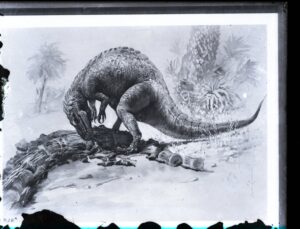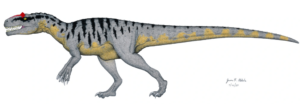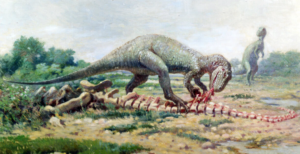There is a large amount of archival material telling many stories about the Joe Webb Peoples Museum, and the old collections of the Wesleyan Museum of Natural History, which closed in 1957. Lilly Hochhauser (’25) is working with the Wesleyan Special Collections and Archives to digitize and safely store this material. One example of material in our archives: this is an image of an ancient glass slide showing an Allosaurus, eating away on the remains of another dinosaur, maybe the tail end of a large Brontosaurus. This glass slide may have been used in projection during a class, and probably dates back to the late 1950s – early 1960s. This is not quite how we think that Allosaurus looked like nowadays, but it is a nice historical picture.

The Allosaurus, as seen on our old glass slide, as compared to a modern (2020) reconstruction of the animal, a large carnivorous dinosaur (or theropod) which lived from about 155 to 145 million years ago, i.e., in the Late Jurassic. Most skeletal material is from the Morrison Formation in the western US, in which it is the most abundant predator. Its type material is in the Yale Peabody Museum (YPM 1930).

The picture on our glass slide was probably inspired by the 1904 image (shown below) by Charles R Knight (1874-1953), the well known American paleo-artist known for his dinosaur drawings, of whom it is said that he ‘determined how the public saw dinosaurs during the first half of the twentieth century’.

